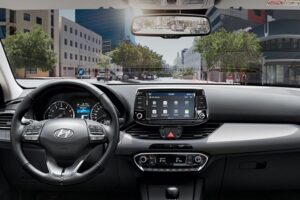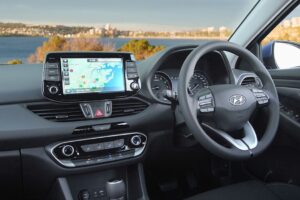A bold opening statement to grab your attention: I can think of very few cars on sale today that give you as much fun per pound as the Hyundai i30 N. Of course, it’s easy to make sweeping generalisations about a concept like “fun” because it isn’t quantifiable, and your idea of it might not align with mine, so it’s very hard to argue against. But surely some things are universal? Don’t we all love big boosty turbo torque, wheel spins, pops and bangs, and on-tap lift-off oversteer?
Maybe if you’ve never grown up…
The i30 N feels like a bit of a class-clown on hot hatch group tests – setting it apart from rivals that seem to get more serious (and in some cases track-focussed) with every generation. Where cars like the Honda Civic Type R entertain by being razor sharp in the pursuit of elusive tenths, the I30 N is all about putting a real-world smile on your face every time you turn the key.
If all of this is sounding distinctly un-Hyundai to you, then you’d be right. The standard i30 suits customers who couldn’t be less interested in any of the above. The N shouldn’t exist, and if it does exist it certainly shouldn’t be any good. But it does, and it’s brilliant.
Please explain why
It’s a simple but satisfying recipe – 2.0-litre turbo, manual ‘box (although a dual-clutch auto is available, and quite good) front wheel drive, limited slip differential. The standard i30’s suspension gets slammed, the subframe reinforced, and the brakes uprated.
From this basic broth we add things like a characterful exhaust note, rev-matched downshifts and torque vectoring, while the dish itself is cooked by former BMW M Division boss Albert Biermann at the Nurburgring Nordschleife.
Previously the menu contained a more basic version with less power and no ‘diff, plus a Fastback body style that made even less sense but was somehow even more glorious for it. This car featured a more pliant ride, which eventually found its way into the hatchback version on sale today.
Now it’s served up at one of those French restaurants that only does steak and chips – there’s one i30 N, and you just pick between manual and auto gearboxes. Oh, and the colour of course.
What’s it like to drive?
Characterfully wayward and rough around the edges, not least in the way the turbo suddenly arrives on-song like an old Subaru rally car. On a damp road you can accelerate away hard and clean, before spinning the wheels in the mid-range. Do so and you’ll feel the diff tugging the wheel, the axle tramping, the traction control light blinking away like it’s trying to tell you to slow down via Morse code. You know, hot hatch stuff.
In the dry grip levels are good but the rear can be easily provoked to swing round on tight turns by dumping the gas pedal. Understeer isn’t entirely absent if you get on the power mid-bend but the diff works hard to avoid it. All the while you’re treated to a coarse and angry soundtrack replete with crackles and bangs that wouldn’t feel out of place on a rally stage. Absolutely glorious stuff.
And on track?
We tested the i30 N at Rome’s Vallelunga on the original launch and found it a good match for long, fast corners – feeling heroically grippy, biting hard on turn-in, and maintaining reassuring chassis balance mid-bend. It’s not a track car for the road in the way the Honda Civic Type R wants to be, but a composed and confidence inspiring thing nonetheless. And a good laugh.
Is it better than a 2023 Honda Civic Type R?
Yes and no – if we’re distilling the remit down to orange squash levels of hot hatch concentration then the Honda has more precise handling, better refinement (especially when it comes down to power delivery) and a significantly swankier interior. However, it’s also really expensive (£10k more on the list price and roughly £150 a month extra to finance) and also quite hard to buy in the UK, due to a small annual allocation.
I am however expectant, and I totally believe this car will be a hit in Africa. In terms of price, well, expensive is relative if you know what you’re getting. As to why they made just 800 globally? Well… that sucks!
We drove both cars back to back and the results were unanimous – the Honda is objectively “better” from a performance perspective but the Hyundai is much more entertaining. And easier to buy. That said, time and inflation has taken a toll on the i30 N, originally on sale for £24,995. Now you can expect to part ways with an extra ten grand, although that is comparing the now off-sale standard car with the equivalent of the top spec.
A lot more than a Ford Fiesta ST or Hyundai i20 N, then
It’s also (marginally) more expensive than a Toyota GR Yaris, and that’s a big problem. Of course none of this will be relevant to you if you need five doors and a usable boot, in which case the i30 N still holds out. But in terms of pure enjoyment, the i30 N always traded on its fun-factor over and above its pure performance. The issue now is that you can get a similarly wide grin from a cheaper i20 N, at even less licence-endangering speeds.
Ultimately the decision will come down to what level of practicality you’re expecting, but the picture is much muddier than it was before.
What do I get for my money?
Numbers wise it’s 276bhp and 289lbs ft, with a 0-62mph time under six seconds. Hyundai promises 35.3mpg is possible but we’ve managed to get less than 20mpg when driving hard. Adaptive dampers give you a variety of selectable modes from comfy Eco to track-focused N mode, via Normal, Sport and mix-‘n’-match N Custom, but all of them feel pretty purposeful. Standard 19-inch alloys come wrapped in Pirelli P-Zero tyres (complete with a specific Hyundai N compound).


What updates has the Hyundai i30 N had since launch?
A set of minor tweaks, largely centred around the suspension. In essence, the slightly more pliant set-up first fitted to the i30 N Fastback has been mapped over to the hatch too. The changes were applied in late 2019, and offered for sale in the UK from early 2020. The suspension changes include new, larger front bump stops, reduced front spring rates, a thinner front anti roll bar and re-tuned front and rear dampers. The ESP software has been updated too.
In all honesty, you’d need a back-to-back test to feel the difference, and when we tested the new set-up more than a year had passed since we were last behind the N’s chunky steering wheel. But the new set-up does feel a mite more supple in terms of ride quality, and the steering slightly lighter than the He-Man-heavy set-up previously.
Ride is still at the uncompromising end of the scale, however; this is a hatch at the hardcore end of the scale. It looks less wild than the Civic Type R, but in some ways is actually the hairier hatch. It’s very much a larger-than-life kind of hot hatch, and the tweaks haven’t changed that – which is a good thing.

Hyundai i30 N: verdict
For a start it’s great value with a substantial standard spec: LED head lights, adaptive cruise control, and 10.25-inch touchscreen sat-nav. Safety features like autonomous braking, lane keep assist and road sign recognition are carried over from the regular i30, plus you also get a five-year warranty.
More to the point, it’s good clean fun to drive. This car may not advance the hot hatch game in terms of outright performance, but for Hyundai, often cited as a maker of beige appliance cars for people not interested in driving, it’s an intergalactic leap. This was the brand’s first proper hot hatch – and it emphatically hit the ground running.
The i30 N is admirable in bringing a sense of humour to a market increasingly obsessed with soulless lap times, often at the expense of emotional enjoyment. Hyundai says this car has been designed to make your heartbeat faster – essentially the opposite of a regular i30, then…
Kudos Hyundai…
source: car mag




